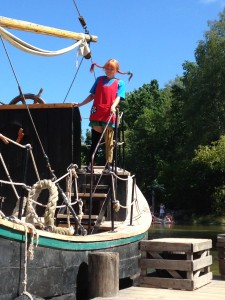One of the things I used to dislike in books were long descriptions. Even descriptions by such masters as Leo Tolstoy and Jane Austen made me sometimes become quite impatient and my brain thinking: “When will the story continue?”
I am sure this just shows my impatience at those moments, not the lack of virtue of the pieces I read. But still, these experiences made me afraid writing descriptions as soon as I started writing fiction myself.
And then several months ago I have read “The Signature of All Things” by Elizabeth Gilbert and became completely dumbfounded. This book is full of descriptions! And many of them where pages and pages long. How could this be?
Last week I read an article in Writer’s Digest from January 2014 by Elizabeth Sims. The title of the article is “Miscalculations and Missteps”. And there in Section 6 named “The Great Undescribed”, I found the following:
“Take a risk and go long. The value of a relatively long description is that it draws your readers deeper into the scene. The worry is that you’ll bore them. But if you do a good job you’ll engross them. Really getting into a description is one of the most fun things you can do as an author. Here’s the trick: Get going on a description with the attitude of discovering, not informing. In this zone, you’re not writing to tell readers stuff you already know – rather, you are writing to discover and experience the scene right alongside them.”
This passage revealed the secret of the SOAT (as Elizabeth Gilbert calls her book), which was hidden for me. SOAT is full of descriptions, but each description is full of discoveries: of love, of own body, of lust, of science, of secrets of universe and its origins and many more. The whole book is continuous discovery. And you can hear this wonder in the voice of the narrator, who mirrors the wonder the main character, Alma Whittaker, experiences through her journey.
The book covers the period of time of more than 50 years! This again goes against the advice I learned: “The shorter the period of time your story takes place the better. Backstory can go further back, but the plot itself should unfold in a short period of time. Otherwise, you will bore the reader.” But SOAT proves this advice completely wrong. It starts with Alma’s birth and finishes with her death.
But even at her death, Alma was discovering. As the Amazon review of SOAT says, Alma is “the insatiably curious“. And I became more and more curious with every sentence I read.
I am very grateful to both Elizabeths (Gilbert and Sims) for lifting my fear from descriptions, for showing me that I can love long descriptions and wish for more, and for giving me a great clue of recognizing a really good one.
And all this led me to a thought which applies to everything: One of the clues to having fun, along with being in the moment, is to be in a constant discovery mode, walking through life ‘with an open mouth’ and being in awe of everything around and inside ourselves.
Pictures: During our recent vacation in South Sweden I rediscovered my love and awe with Karlson on the Roof (from a series of stories written by Astrid Lindgren). I forgot over the years how much I loved these stories and the animated films based on these stories and created in Soviet Union. We visited Astrid Lindgren’s World theme park in Vimmerby, Astrid Lindgren’s birth place. Niklas wanted to see Pippi Longstocking and her house. And when we did it, I knew I wanted to see Karlson, or at least his house. And then as Niklas and I were on the roof at Karlson’s door, we saw him singing and dancing in the street in front of the house. We hurried downstairs to see more. It was such fun to see a childhood’s hero live. And it is an absolute pleasure to witness my son discovering his childhood heroes.



